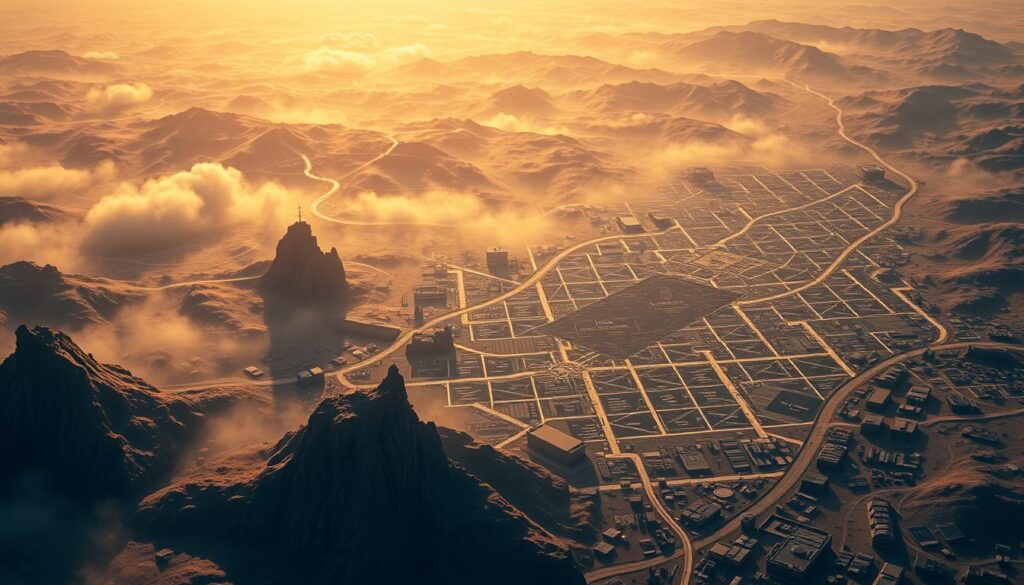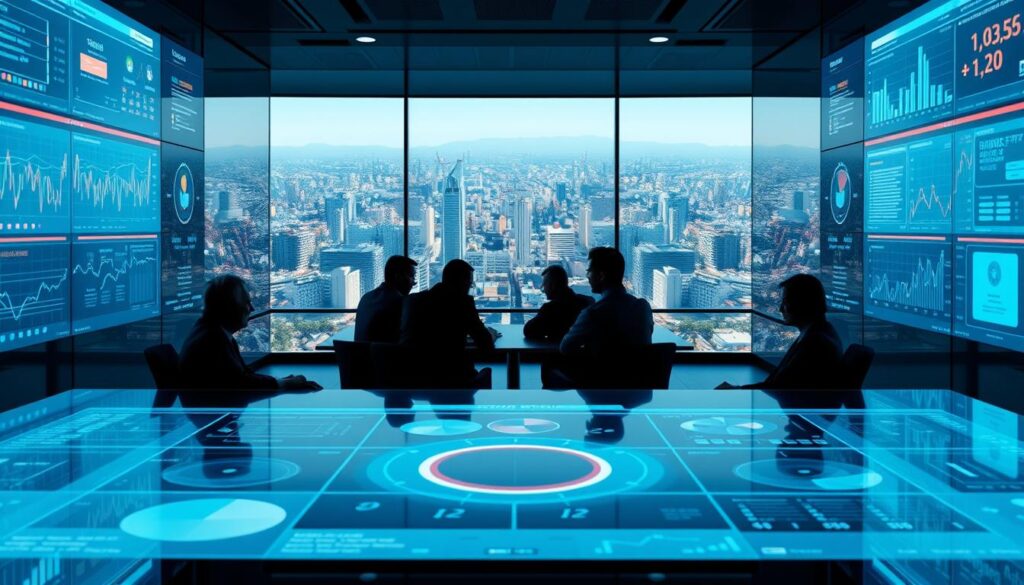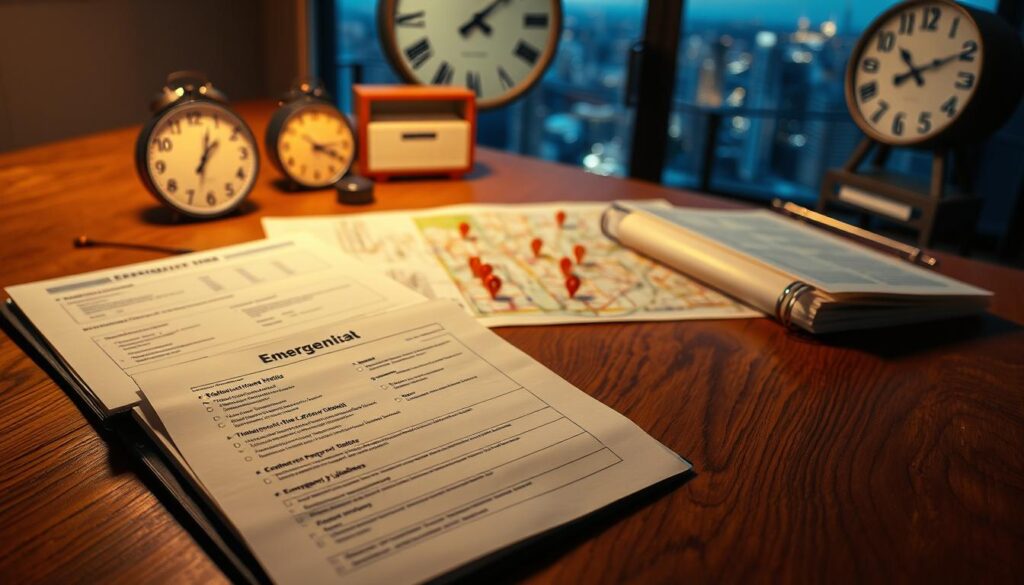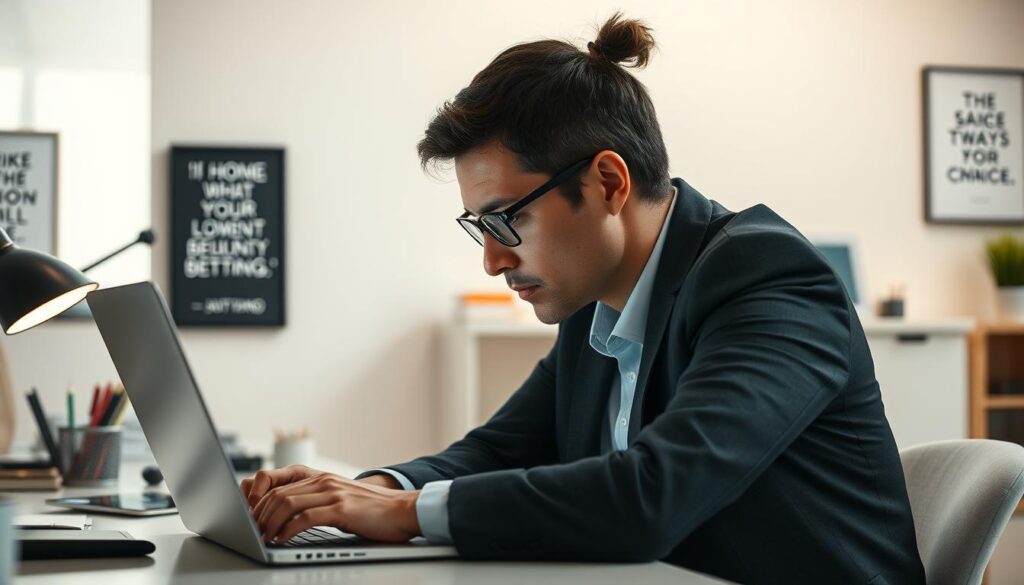Thinking about emergencies, I see how vital a good plan is. It keeps us safe and reduces harm. Making an emergency preparedness plan might look hard, but it’s doable step by step.
A plan helps us act fast when disasters hit. It’s key to think about many scenarios. This way, we can cover all our bases.
By following a step-by-step guide to Preparedness Planning, we can get ready for surprises.
Key Takeaways
- Create a detailed emergency preparedness plan
- Break down the planning into easy steps
- Think about different emergency situations
- Make a plan that meets all our needs
- Keep the plan up to date
Understanding Preparedness Planning
The base of disaster preparedness is preparedness planning. It means spotting risks and finding ways to lessen them. This is key for a strong community that can handle emergencies well.
To see why planning is important, we need to know its main parts. Preparedness planning phases include checking risks, setting up resources, and making plans. Knowing these helps people make their own emergency plans.
What Is Preparedness Planning?
Preparedness planning is about finding dangers, seeing weak spots, and making plans to lessen disaster effects. It’s a step ahead, helping people and groups react better in crises.
The Importance of Preparedness Planning
The role of preparedness planning is huge. With a good plan, people can lower disaster risks and respond better. Good disaster preparedness strategies mean being ready before emergencies hit, not just reacting.
A solid crisis management plan is key. It shows how to act before, during, and after emergencies. It makes sure everyone works together. This plan should be checked and updated often to keep up with new risks and ways to handle them.
In short, knowing about preparedness planning is essential for good disaster preparedness strategies and a strong crisis management plan. By understanding these, people can get better at facing emergencies and disasters.
Identifying Risks in My Environment
To create a strong risk mitigation strategy, I need to spot hazards around me. It’s important to know the different risks that could affect my life and those of others.
Natural Hazards
Natural hazards like earthquakes, hurricanes, floods, and wildfires are big concerns. They can harm communities a lot, causing loss of life and damage to property. It’s key to know the chances and effects of these hazards in my area.
For instance, if I live in an earthquake-prone area, having an evacuation plan and knowing safe spots is vital. Also, knowing the flood risk helps me take steps like raising electrical outlets and installing flood-proof barriers.

Technological Threats
Technological threats, like cyber-attacks and industrial accidents, are also major concerns. In today’s world, the risk of tech failures or malicious activities causing big problems is high.
To tackle these risks, I must be aware of the tech threats around me. This means understanding how to prevent cyber-attacks and being ready for industrial accidents.
Human-Caused Risks
Human-caused risks, like terrorism or vandalism, are unpredictable but need attention. Knowing the risks and how to react can help lessen their impact.
Creating an emergency response plan for different scenarios is essential. This plan should be shared with my family and updated often to reflect changes in my environment or personal life.
Assessing My Resources
It’s important to know what I have for emergency planning. I need to check what I have, what I can count on, and what I might need more of.
Evaluating Financial Resources
Looking at my money is key. I should think about my savings, emergency funds, and any bills that could affect my emergency readiness. Knowing my financial situation helps me plan how much to spend on emergency prep.
Some important money matters to look at include:
- My current savings and emergency fund balances
- Any debts or financial obligations
- My ability to get more money if needed
- Insurance coverage, like health, home, and auto
Inventorying Emergency Supplies
Then, I should check my emergency supplies. I need to see what food, water, first aid kits, and other essentials I have. This helps me find what’s missing and make sure I have enough.
Important items to check include:
- Non-perishable food and water
- First aid supplies and medications
- Flashlights, batteries, and other light sources
- Communication tools, like cell phones and two-way radios
Identifying Skills and Talents
Lastly, I should think about my skills and those of my family. This includes first aid, CPR, and other emergency skills. Knowing our strengths helps us work better together in emergencies.
Some skills to think about include:
- First aid and medical skills
- Communication and coordination skills
- Technical skills, like electrical or plumbing
- Survival skills, like navigation and building shelters
By looking at all my resources, I can make a better emergency plan. This plan will use my money, supplies, and skills to prepare for emergencies.
Creating a Family Emergency Plan
Creating a family emergency plan is key to keeping your loved ones safe. It’s a big part of your emergency plan, showing how to act in a crisis.
Involving Family Members
It’s important to get everyone involved in making the plan. Start by talking about why emergency plans are important. Then, give each family member tasks based on what they can do. This makes everyone feel responsible and ready to act in an emergency.
Think about what your family members need, like babies, older people, or those with disabilities. This way, your plan can really help them.
Communication Strategies
Good communication is key in an emergency. Make a plan for how to stay in touch, like a phone number or a place to meet. Make sure everyone knows the plan and how to find each other if you get lost.
Choose a meeting spot outside your home and a contact person who lives far away. This helps everyone stay safe and have a way to check in.
Identifying Meeting Points
Finding safe places to meet is important. Pick spots that are easy to get to and that everyone knows. Have both indoor and outdoor spots, like a place near your home or a local landmark.

Also, find safe ways to leave your home and know about dangers in your area. With a good plan, you can reduce risks and respond better in an emergency.
Building an Emergency Kit
Creating a well-stocked emergency kit is key for responding to emergencies. It’s a collection of essential items for survival during disasters or crises. This kit helps me and my family stay safe.
Having an emergency kit is very important. It gives us the tools and supplies we need to handle emergencies on our own. Ready.gov says it makes us better prepared for disasters.
Essential Items to Include
My emergency kit needs to have many important items. These include:
- Water and non-perishable food
- First aid supplies, like bandages and pain relievers
- Flashlights, batteries, and a battery-powered radio
- Extra cash and important documents, such as insurance policies
- A whistle to signal for help if needed
For more tips on building a disaster kit, I can check out Survivalist Bottles. They offer great advice on putting together a kit.
Seasonal Considerations
Seasonal factors are important when making my emergency kit. In winter, I need warm clothes, blankets, and maybe a portable heater. Summer kits should have sun protection, hydration, and cooling items.
Maintenance and Updates
Keeping my emergency kit up to date is essential. I should check it every six months. This means checking batteries, updating medications, and replacing food and water.
By regularly checking and updating my kit, it stays a key part of my emergency response plan. It gives me the resources I need in any situation.
Developing a Communication Strategy
To stay in touch with family and emergency services in a crisis, I must have a good communication plan. I need to pick the best tools and make a contact list. This way, I can communicate smoothly.
Choosing Reliable Communication Tools
When picking communication tools, I look at reliability, how easy they are to use, and if they’re accessible. Top choices include cell phones, two-way radios, and satellite phones.
Reliable Communication Tools:
- Cell phones with backup power sources
- Two-way radios for short-range communication
- Satellite phones for emergency situations
| Tool | Reliability | Accessibility |
|---|---|---|
| Cell Phones | High | Easy |
| Two-way Radios | Medium | Moderate |
| Satellite Phones | High | Difficult |
Establishing a Contact List
Making a contact list is key. It lets me quickly reach family and emergency services. I include important numbers like my emergency contact and local emergency services.
Tips for Creating a Contact List:
- Include names and phone numbers of family members
- Add emergency contact numbers, such as the police and fire department
- Save important numbers in my phone and write them down in a notebook

By picking the right tools and making a contact list, I can keep in touch effectively during a crisis.
Practicing My Plan
Practicing my emergency plan helps me find weak spots and get stronger. It’s not just about following a script. It’s about knowing how to act when it really matters.
To begin, I do regular drills for different emergencies. This makes me and my family know the plan by heart.
Conducting Drills
Drills are key to practicing my emergency plan. They help me:
- Check if my communication plan works
- See if my emergency kit is ready
- Learn evacuation routes and procedures
For example, a fire drill can show me what needs fixing. Like finding new escape paths or teaching everyone how to use fire extinguishers.
Evaluating the Effectiveness of My Plan
After drills, I check how well my plan works. I see what’s good and what needs fixing.
Checking my plan’s effectiveness lets me improve. I can:
- Find missing parts in my plan
- Update my emergency kit and supplies
- Make my communication plan better
By practicing and checking my plan often, I’m ready for emergencies. I can also lower the risks.
Staying Informed
It’s key to stay informed for my preparedness planning. This helps me react fast in emergencies and make smart choices for my disaster recovery plan and continuity of operations plan.
To stay informed, I need reliable sources for emergency alerts. These can be local news, weather reports, and emergency alert systems.
Resources for Emergency Alerts
There are many resources for emergency alerts. Here are a few:
- National Weather Service (NWS) for weather-related emergencies
- Emergency Alert System (EAS) for emergency alerts
- Local news and emergency management websites
I can also sign up for emergency alerts from my local government or emergency management agency. This way, I get timely updates and instructions.
Following Local Guidelines
It’s also vital to follow local guidelines and recommendations. This includes:
| Guideline | Description | Benefit |
|---|---|---|
| Emergency Evacuation Routes | Knowing the safest routes to take in case of an emergency | Reduces risk of injury or harm |
| Shelter Locations | Identifying safe locations to seek shelter during emergencies | Provides a safe haven during emergencies |
| Emergency Contact Information | Having important contact numbers readily available | Facilitates quick communication during emergencies |
By following local guidelines and staying informed, I can make sure my preparedness plan works. This way, I’m ready to face emergencies head-on.
In conclusion, staying informed is a must for my preparedness planning. Using resources for emergency alerts and following local guidelines helps me respond better to emergencies. This way, I can reduce risks and stay safe.
Reviewing and Updating My Plan
A key part of Preparedness Planning is checking and updating my emergency plan often. This keeps my plan up-to-date and ready for new situations.
To do this, I set a time to review my plan, like every six months. I look at my plan’s effectiveness and make changes if needed. I also think about any personal changes, like moving or family updates.
Scheduling Regular Reviews
Regular reviews keep me on track with emergency prep. I use a calendar to mark these reviews and set reminders. It’s good to link these reviews to big events or seasonal changes, so I remember.
Incorporating New Developments
I also update my plan for new things. This could be new tech, changes in local dangers, or updates in emergency responses. Adding these to my plan keeps it useful and current.
By regularly checking and updating my emergency plan, I stay ready for anything. This ongoing effort is key to business continuity planning and being prepared.
Conclusion: Commitment to Preparedness Planning
Reflecting on creating an emergency response plan, I see its importance. It’s key for my safety and the community’s well-being.
My part in emergency preparedness is to stay informed. I also need to regularly update my crisis management plan. And I should encourage others to do the same.
Empowering Community Preparedness
By fostering a culture of preparedness, I help make our community stronger. It becomes better at handling emergencies and crises.
Maintaining Vigilance
To keep my emergency plan effective, I must stay alert. I need to adapt to new risks and challenges. This way, I can better respond to emergencies.
FAQ
What is preparedness planning, and why is it important?
Preparedness planning means making a plan for emergencies and disasters. It’s key to reduce the impact of emergencies. It also keeps businesses running and people safe.
How do I identify my environment’s risks?
Look at natural hazards, tech threats, and human risks in your area. Think about how likely and big these risks are. Then, plan how to lessen their effects.
What should I include in my emergency kit?
Your kit should have food, water, first aid, and a battery radio. Remember to add seasonal items and update it often. This keeps it useful and ready.
How often should I review and update my emergency plan?
Update your plan every six months. This keeps it current and effective. Include new info, update contacts, and practice to improve.
What is the importance of practicing my emergency plan?
Practicing your plan is key to being ready for emergencies. Drills help find and fix weak spots. They make sure everyone knows their part.
How can I stay informed about emergencies and disasters?
Sign up for emergency alerts and follow local rules. Stay updated with reliable news. This helps you act fast and right.
What is the role of business continuity planning in preparedness planning?
Business continuity planning keeps businesses running in emergencies. It involves key functions, backup plans, and risk cuts. It’s vital for survival.
How can I encourage community preparedness?
Share your knowledge and join local efforts. Talk about the need for preparedness. This helps everyone get ready.
What is a risk mitigation strategy, and how can I develop one?
A risk strategy lowers the chance of harm. Identify risks, assess them, and act to reduce them. This keeps you safe.
What is a disaster recovery plan, and how does it relate to preparedness planning?
A disaster recovery plan helps get things back to normal after a disaster. It’s part of being prepared. It ensures quick recovery.
How can I develop a continuity of operations plan?
Identify key functions, make backup plans, and cut risks. This lets you keep going even in tough times.
What is a crisis management plan, and how does it relate to preparedness planning?
A crisis management plan handles emergencies. It’s key to preparedness. It helps you respond well and lessen damage.



